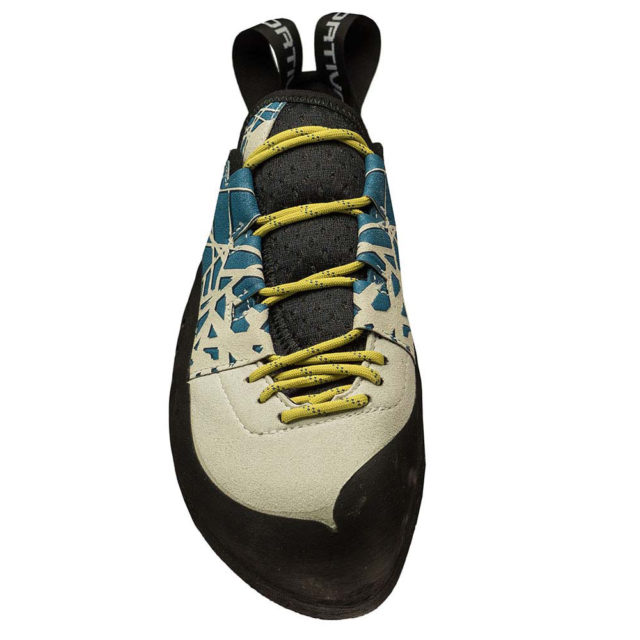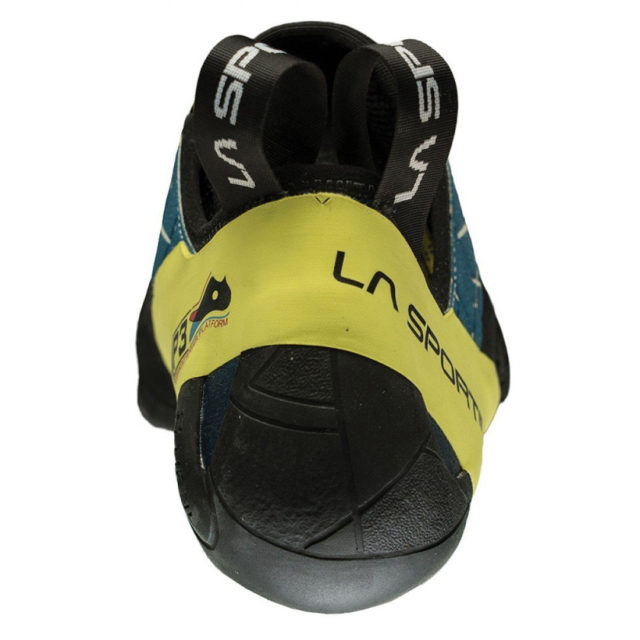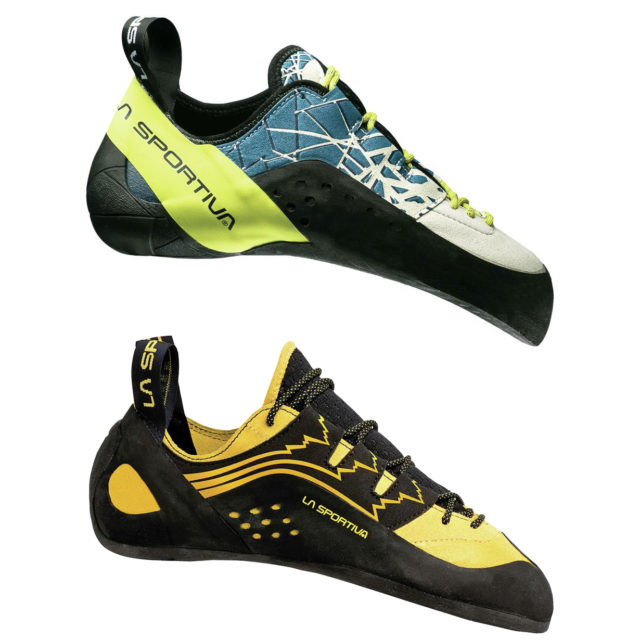
La Sportiva Kataki
Available Sizes: EU M’s 33-46; EU W’s 32-43
Reviewer Street shoe size: EU M’s 42
Size Tested: EU M’s 41
Stated Weight Per Shoe: 266 g
Blister’s Measured Weight Per Shoe (size 41): 295 g
Construction:
- Last: PD 75
- Upper: Suede leather / Microfiber
- Lining: Pacific (in front and back)
- Midsole: 1.1 mm LaspoFlex with P3®
- Sole: 4 mm Vibram® XS Edge™
MSRP: $170
Test Locations: Wild Iris, WY; Bozeman Area & Gallatin Canyon, MT; Indian Creek, UT
Days Tested: 60
Intro
The La Sportiva Kataki is the lace-up version of their Otaki, which Dave Alie reviewed last year and found to be an excellent shoe for climbs that involve both technical face climbing and a bit of crack climbing, making it a very strong contender in the “one shoe for everything” category. But the Otaki was also very similar to another excellent option in the 1-shoe quiver category, the La Sportiva Katana Lace. So this begs the question, “Why go with the Kataki when the Katana Lace and Otaki are both strong 1-shoe quiver options?”
Well, the Kataki takes many features of the Katana Lace (my personal favorite shoe of all time) and combines them with the slightly more aggressive last and face-climbing-oriented design of the Otaki. I used the Kataki on a wide variety of climbs to see how this Otaki / Katana Lace hybrid performed, and to figure out if the Kataki would be the shoe that would finally replace the Katana Lace.
Last and Geometry
Many of the features of the Kataki are nearly identical to that of the Katana Lace, from the lacing to the neoprene sock liner. That said, the two shoes have subtle differences, namely in the shape and stiffness of the toe box and the amount of downturn and asymmetry of the two shoes’ lasts.
The Kataki uses an almost identical lacing system as the Katana Lace, which consists of more concentrated lacing near the toe and more spaced-out lacing over the midfoot and near the ankle. The idea behind this is that it’s supposed to help you really fine-tune the fit of the shoe more so than with a traditional lacing system. The Kataki also features the tubular neoprene tongue of the Katana Lace, which helps make the Kataki one of the most comfortable downturned shoes I’ve ever worn.

The toe box of the Kataki is wider than many other aggressive shoes I’ve used, and when combined with its lace-up closure (as opposed to velcro), this gives the climber more precision when tightening the shoe.
I tend to use lace-up shoes because I have wide toes and lace-ups let me get a bit more room near the end of the shoe. I was able to significantly open up the Kataki’s toe box for climbing longer or more casual routes, and was also able to wrench its laces super tight for routes where I was willing to sacrifice some comfort for the increase in precision.
The Kataki is built with the same “S-Heel” construction as the Otaki, which uses a raised piece of rubber on the inside of the heel that’s supposed to provide more stability / tension while heel-hooking. The Katana Lace does not have this feature, and I did notice that the Kataki felt more solid when locking into heel-hooks, so that little band of rubber seems to perform as advertised.

The final and arguably most important difference between the Katana Lace and the Kataki is these shoes’ lasts. The Katana Lace is built on Sportiva’s “PD 55” last, which is the same last used on their crack-climbing-oriented TC Pro. The Kataki and Otaki both use Sportiva’s more aggressive “PD 75” last, which is also used on some of their other high-performance face climbing shoes like the Solution and Futura.
What all this means is that, when compared directly to the Katana Lace, the Kataki is slightly more downturned and has a slightly higher degree of asymmetry, which makes sense given the Kataki’s increased inclination towards precise footwork on micro-holds (rather than cracks).

[Note: Sportiva’s last naming scheme is based on how aggressive the geometry of the shoe is — the “PD” stands for Power / Downturn, and the higher the number, the greater the downturn and asymmetry of the shoe. Of course, many factors other than the last affect the way a shoe feels and performs, but this “PD” number is still a useful data point.]
Size & Fit
My foot is a bit oddly shaped with a narrow heel, flat arch, and wide forefoot. This means I often have trouble fitting my feet into downturned shoes without excruciating foot pain while I do my best ballerina impression.
Luckily, most of La Sportiva’s lace-up shoes fit my feet quite well as their lace-ups tend to have wider toe boxes than their velcro offerings. I sized down one full EU size from my street-shoe size for the Kataki and am quite happy with the result. The Kataki’s leather / microfiber upper stretched about a fourth of a size after my first week of climbing in them and I’ve been able to comfortably wear the Kataki in the gym for up to about two hours straight. As I noted above, the Kataki is a very comfortable shoe for how aggressive its shape is.
Performance
Face Climbing
La Sportiva says the Kataki is designed for “steep edging and precise footwork,” a claim that I put to the test on a variety of rock types this past year. From the pocketed limestone of Wild Iris, to technical edging on the limestone crags around Bozeman and the slippery gneiss of Gallatin Canyon, the Kataki performed quite well throughout.
When pulling on small pockets, I occasionally found myself wanting a slightly more aggressive and downturned shoe to pull my center of gravity closer to the wall, but overall the Kataki performed excellently on climbs with sustained technical edging at just past vertical.
And while there are plenty of super-aggressive shoes out there that perform really well on difficult climbs, the Kataki’s versatility is what really makes it stand out. I found the Kataki to shine on terrain like that in the limestone crag at Natural Bridge, MT, which is characterized by its dead-vertical crimps and occasional pockets. The Kataki also did really well in the Gallatin Canyon, which features polished gneiss and movements that switch between face climbing and cracks. Which leads us to….
Crack Climbing
For a long time, I used a 2-shoe quiver for crack climbing, relying on the La Sportiva TC Pro for routes where I wanted the increased support of a stiffer sole or the Five Ten Moccasym where I wanted to lower-profile shape and softer, more sensitive feel. That was until I pulled on a pair of Katana Laces and thought I had found the Holy Grail — a shoe with a medium-stiff sole, slightly pointed toe box, and with slight downturn. So after discovering the Katana Lace I rocked the 3-shoe quiver for years, finding it difficult to unseat any of those three shoes.

Part of me wishes I had never tried on the Kataki out of respect for the Katana Lace, a shoe I affectionately refer to as “the destroyer of worlds.” Over the past several years I’ve almost exclusively worn the Katana Lace on hard trad climbs, particularly ones with thin cracks and micro foot chips where I take advantage of its precise toe shape and moderate stiffness. But I think the Kataki takes many of the qualities that make the Katana Lace such a good shoe for difficult trad climbs and makes them even better.
Compared to the Katana Lace, the Kataki feels ever so slightly softer through the toe box and has less of a pronounced ‘knuckle’ on top of the toes. As a result, I found that I was able to utilize more of the rubber on the Kataki in difficult finger cracks compared to the slightly bulkier toe of the Katana Lace. At the same time, the Kataki still provided equal (if not slightly better) precision when standing on near-imaginary microchips on the face the wall.
But while the Kataki does slightly better than the Katana Lace on really difficult trad climbs, the softer toe on the Kataki did make standing on small edges for a long time more tiring than when wearing the Katana Lace or TC Pro.

So does this mean that the Kataki will replace the Katana Lace, my beloved destroyers? Well … it’s complicated. I think the Kataki is an excellent shoe that excels on thin cracks and steep faces. That said, I think the Katana Lace is a more versatile all-around shoe, especially for longer trad climbs. The Katana Lace is slightly less downturned and a bit stiffer, providing more support while edging and making it work slightly better in wider cracks where a less downturned shape is useful.
Durability
I’ve worn the Kataki for about 60 days on both rock and plastic, and have not yet seen any significant damage to the shoe besides normal wear and tear. The Kataki’s Vibram XS Edge rubber has held up about as well as other Sportiva shoes I’ve used (e.g., the Katana Lace), and in my experience the XS Edge rubber is slightly more durable than the C4 rubber on Five Ten shoes like the Moccasym.
Perhaps more significantly, I haven’t seen any delamination on the top of the Kataki’s rand along the toe box, a problem that I experienced on some older La Sportiva shoes. I’m not sure if the company changed their rubber or manufacturing process, but it’s nice to see that, at least on the pair of Kataki’s I tested, that problem seems to have been solved.
Bottom Line
The La Sportiva Kataki performs extremely well on a wide variety of climbs and rock types, but it really shines on trad climbs that combine difficult cracks and vertical edging. The Kataki’s combination of a softer, low-profile toe box, medium stiffness underfoot, and comfortable lacing system has made it my go-to shoe for thin cracks.
There are better shoes on the market for super-steep pocket-pulling (e.g., La Sportiva Solution), and better shoes for long trad routes (e.g., La Sportiva TC Pro or Five Ten Anasazi Lace). But when it comes to one shoe to use for both technical face climbing and difficult cracks, the Kataki is one of the best all-around shoes I’ve used.

Thanks for the great review. It sounds like your foot has a similar shape to mine. Have you tried the scarpa vapor lace? I’ve been really impressed with that shoe as an all round ‘destroyer of worlds’, and from your description of the katana lace sounds very similar.
Also, which of the two (kataki and katana L) do you feel has the widest toe box?
Hey JH, good questions. Regarding the Vapor Lace, I haven’t actually ever tried it on, I’ve just climbed a little in the Vapor V. I think the Vapor lineup is the closest thing Scarpa offers to compete with the Katana Lace/Kataki style shoe from Sportiva so your comparison is definitely valid. From my limited experience, I think the Vapor V is pretty similar in stiffness to the Kataki, but I don’t know about the Vapor Lace.
As far as the toe box goes, I think the width is pretty similar between the Kataki and the Katana Lace. I think the Kataki is slightly narrower than the Katana Lace, but that may also be a function of the relative downturn and asymmetry of each shoe rather than a significant difference in the width. Part of the reason why I generally prefer lace-up shoes to velcro is that there’s a bit more room for fine-tuning the fit with laces.
Awesome review, thanks for posting. Quick question for you: Do you find that there is a significant difference in the performance between the Katana L and the Kataki for vertical and just-past-vertical routes?
I just got the Katana’s this past December as my first performance shoes and I love them. But I may want to delegate them to Trad-use only (as I didn’t downsize quite enough) and get a new pair for technical sport climbing shoes. I’m primarily concerned with performance on dime-sized edges and technical face climbing in the 5.9 – 5.11 range.